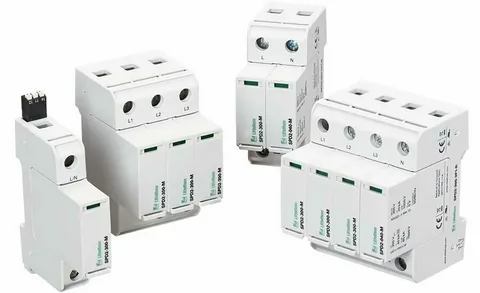| Introduction The Surge Protection Devices (SPD) Market is a cornerstone of modern electrical safety and power quality strategy. SPDs protect electrical and electronic systems from transient overvoltages caused by lightning strikes, switching operations, utility grid perturbations, and equipment switching. As electrification intensifies, digitalization spreads, and mission-critical infrastructures such as data centers, telecom networks, industrial automation, and renewable energy farms proliferate, the requirement for reliable surge protection becomes indispensable. SPDs minimize equipment damage, reduce downtime, and protect sensitive assets — delivering tangible economic value by averting costly repairs and service interruptions. The market spans devices for residential, commercial, industrial, and utility applications and encompasses primary protection types including Type 1 (lightning/utility), Type 2 (distribution), and Type 3 (point-of-use) solutions. Market Drivers Several converging factors are driving SPD market growth. First, the acceleration of digital infrastructure — particularly data centers, edge computing sites, and telecommunication nodes — demands high-availability power systems protected from transient events. Second, the global rollout of renewable energy and distributed generation (solar PV, wind, and battery energy storage systems) increases grid variability and switching events that can create transient overvoltage risks; SPDs are critical to protect inverters, charge controllers, and storage systems. Third, urbanization and increased building electrification create denser deployments of sensitive electronics in both commercial and residential sectors. Fourth, stringent electrical safety regulations and standards (IEC, IEEE, NEC, regional codes) are encouraging or mandating surge protection in many installations. Finally, growing awareness of total cost of ownership pushes asset owners to invest in prevention rather than repair, thus favoring SPD adoption across industries. Market Challenges The SPD market faces several notable challenges. Product efficacy depends heavily on proper system design and earthing/grounding quality; poor grounding or incorrect installation can render SPDs ineffective, yet installation practices vary widely by region and skill level. Fragmented regulatory environments and differing standards across countries complicate product development and certification for global manufacturers. Another challenge is the prevalence of counterfeit and low-quality devices in some markets, which undermines trust and can lead to catastrophic equipment failures. Price sensitivity in developing economies can deter adoption of high-performance SPDs, while highly conservative procurement cycles in utility and industrial sectors slow decision-making. Finally, rapid changes in load profiles and grid behavior, driven by EV charging and distributed resources, demand continuous product innovation to keep protection solutions effective. Market Opportunities Opportunities in the surge protection market are broad and expanding. The transition to IoT-enabled and smart SPDs that report status, event history, and health metrics over Ethernet, Modbus, or cloud platforms creates value-add services like predictive maintenance and centralized asset management. Integration with power quality monitoring and harmonics mitigation positions SPDs as part of wider power reliability suites rather than standalone devices. Rapid growth in EV charging infrastructure, where repeated switching and high inrush currents can stress electrical systems, opens a large new vertical for specially specified SPDs. Renewable energy projects and BESS installations require surge protection designed for DC systems and bi-directional power flows — a niche with rising demand. Retrofit opportunities in aging infrastructure, especially in utilities and industrial parks, also represent a steady pipeline as operators upgrade to modern protection strategies. Regional Insights North America exhibits mature SPD adoption driven by stringent codes, high data center density, and distributed energy projects. The U.S. leads in smart grid pilots and resilience programs, pushing SPD use. Europe is characterized by strong regulatory frameworks and a major focus on protecting renewable and offshore installations; Germany, the UK, and Nordic countries show advanced uptake. Asia-Pacific is the fastest-growing region owing to rapid industrialization, rooftop and utility-scale solar expansion, and large-scale electrification initiatives in China, India, and Southeast Asia. Price-sensitive segments in these markets still favor lower-cost units, but enterprise and utility projects demand premium, certified devices. Middle East & Africa and Latin America are emerging markets where infrastructure projects, mining, and oil & gas expansions create demand for industrial-grade surge protection. Future Outlook The SPD market’s future will be shaped by digitalization, standard harmonization, and new application domains. Expect continued convergence between SPDs and power quality monitoring platforms, with manufacturers offering cloud dashboards, remote alarming, and lifecycle analytics. The growing prevalence of DC distribution for data centers, telecom shelters, and EV infrastructure will spur development of DC-capable surge protectors and combined AC/DC modules. Regulatory harmonization and stricter enforcement of installation best practices will improve end-user outcomes and reduce failures attributed to poor implementation. Advances in materials and surge energy handling topologies will yield smaller devices with higher energy absorption and faster response times. Overall, the market is projected to grow steadily as electrification, digital services, and renewable integration expand globally. Conclusion The Surge Protection Devices Market is an essential protector of modern electrified assets. While challenges remain around installation quality, counterfeit products, and regional fragmentation, opportunities from smart, IoT-enabled devices, renewable and EV infrastructure, and retrofit programs are compelling. For stakeholders — from utilities to data center operators and builders — SPDs are no longer optional accessories but fundamental components of resilient, reliable electrical systems that safeguard operations and reduce long-term costs. |
